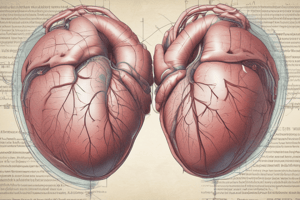Podcast
Questions and Answers
What is the most common type of atrial septal defect (ASD)?
What is the most common type of atrial septal defect (ASD)?
- Patent ductus arteriosus (PDA)
- Ventricular septal defects
- Ostium secundum defects (correct)
- Muscular part defects
Which structure is responsible for closing the interventricular foramen at the superior part of the ventricular septum?
Which structure is responsible for closing the interventricular foramen at the superior part of the ventricular septum?
- Inferior endocardial cushion tissue (correct)
- Ductus arteriosus
- Septum primum
- Muscular part of the interventricular septum
What causes the physiological closure of the ductus arteriosus after birth?
What causes the physiological closure of the ductus arteriosus after birth?
- Excessive resorption of septum primum
- Bradykinin release (correct)
- Blood flow from right to left
- Smooth muscle contraction
What is the function of the atrial septum in foetal circulation?
What is the function of the atrial septum in foetal circulation?
What is the shape of the septum primum during its development?
What is the shape of the septum primum during its development?
What condition results from the failure of the septum primum to close properly?
What condition results from the failure of the septum primum to close properly?
What happens to the lungs during the transition from pre-natal to post-natal circulation?
What happens to the lungs during the transition from pre-natal to post-natal circulation?
What is a common symptom of atrial septal defects in older children and adults?
What is a common symptom of atrial septal defects in older children and adults?
Which heart chamber has higher pressure in post-natal circulation?
Which heart chamber has higher pressure in post-natal circulation?
Flashcards are hidden until you start studying




